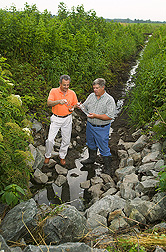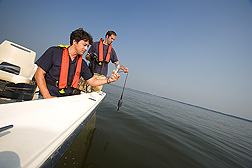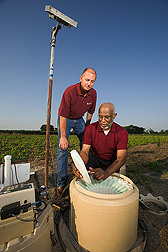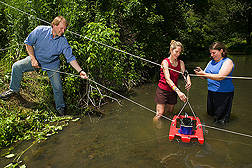ARS’s Quest To Improve the Chesapeake Bay
Blue crabs and plump oysters. Rockfish and yellow perch. These are just a few of the living treasures that reside in the Chesapeake Bay. But those treasures are at risk of disappearing one day because of persistently poor water quality.
The Chesapeake Bay is an example of a waterway that is stressed by animal and crop production across its entire watershed, a landmass of 64,000 square miles. This area includes parts of New York, Pennsylvania, Maryland, Delaware, Virginia, West Virginia, and all of Washington, D.C. Activities even at the outermost points of the watershed can affect the delicate balance of the bay’s ecosystem.
The condition of the Chesapeake Bay is not in dispute: In the summer of 2005, oxygen levels reached their lowest point since monitoring began in 1984, according to the multi-agency Chesapeake Bay Program (CBP). Submerged aquatic vegetation is in decline, and oysters are at about 1 percent of historical levels. While blue crabs have rebounded slightly, they too are substantially below past numbers.
Several Agricultural Research Service (ARS) research groups are investigating ways to mitigate or prevent harm from farming practices. The scientists are working to improve phosphorus management; nitrogen efficiency; and manure composting, testing, and treatment to prevent movement of pollutants into the bay.
But how can they tackle all the bay’s water quality issues and find solutions? With help from others who have the same concerns.
It Takes a Consortium
Within the CBP, a group of federal and state agencies, universities, and foundations is pooling all its resources in projects to monitor the bay’s progress and find solutions to serious water-quality problems. Ali Sadeghi, soil physicist with the Hydrology and Remote Sensing Laboratory at Beltsville, coordinates bay-related ARS research projects with this consortium.
One such project, led by ARS scientists, is assessing the effectiveness of natural resource conservation practices in the Choptank River Watershed, a part of the larger Chesapeake Bay drainage basin. The organizations tackling this task include USDA’s ARS and Natural Resources Conservation Service (NRCS), the Chesapeake Research Consortium, the University of Maryland’s Center for Environmental Science (Horn Point Laboratory), the National Oceanic and Atmospheric Administration, and the Smithsonian Environmental Research Center. This research is part of a larger USDA effort called “CEAP” (the Conservation Effects Assessment Project), which spans watersheds nationwide to assess the benefits and value of national conservation efforts.
“In fiscal year 2004, more than $330 million was spent by federal agencies toward various protection-and-restoration goals for living resources, vital habitat, water quality, sound land use and stewardship, and community engagement,” says ARS’s Ron Korcak, associate director of the ARS Henry A. Wallace Beltsville [Maryland] Agricultural Research Center, and a member of the CBP’s Scientific and Technical Advisory Committee.
Good News, Bad News
Plant nutrients, mostly phosphorus and nitrogen, can damage waterways if their amounts are excessive. They can cause rapid growth, or “blooms,” of algae and other microscopic plant life. Algal blooms reduce sunlight available to submerged aquatic vegetation, killing the plants and eliminating habitat for crabs and other species. Then, the dead algae sink and are decomposed by bacteria. This process depletes oxygen in the waters, which can kill fish and other species unless they can move to suitable areas with enough oxygen.
The good news is that total loads of both nutrients have fallen since 1985. Then, 27.1 million pounds of phosphorus entered the bay, but in 2002 only 19.5 million pounds did. As for nitrogen, 338 million pounds entered the Bay in 1985, and just 278 million pounds did in 2002. The bad news is that those levels may still be too high. Despite this nutrient load decline, 3 percent of the bay’s waters had almost no oxygen in the summer of 2005, and 21 percent had low oxygen levels, according to the CBP.
How To Reduce Nutrients
About 41 percent of the nutrients that reach the bay comes from agricultural activities, according to Matt Smith, research leader at ARS’s Environmental Management and Byproducts Laboratory, in Beltsville. “The rest comes from sources such as urban stormwater, wildlife droppings in forests and natural areas, and municipal wastewater-treatment effluent,” he says.
Soil scientist Greg McCarty has done extensive research on use of riparian buffer zones to reduce the amount of nutrients getting into waterways. McCarty works in the Hydrology and Remote Sensing Laboratory at Beltsville.
Riparian zones are wooded or grassy areas in wetlands and on streambanks that filter out pollutants and excess nutrients. “We know that riparian zones can filter out a significant amount of excess nutrients. As part of the Choptank CEAP project, scientists are now using historical data and current monitoring to assess the impact of conservation practices like riparian zones and cover crops on environmental issues such as quality of water entering the Bay,” says McCarty.
Smith notes another approach researched in his laboratory: using algae to remove nitrogen and phosphorus from dairy wastewater. “Manure wastewater is passed through a treatment system known as an ‘algal turf scrubber,’ in which the nutrients are used to grow algae,” says Smith. “The algae is then harvested and dried for later use as fertilizer or even animal feed.”
Road to Recovery
Knowing how much phosphorus is already in the soil will help prevent excess applications. That’s why scientists at the Pasture Systems and Watershed Management Research Unit led development of the Phosphorus Index, a measure of the risk of phosphorus loss from different agricultural fields and the potential for that phosphorus to enter streams, lakes, and reservoirs. This approach has helped farmers fine-tune applications and decrease the amount of phosphorus running off their land.
Nitrogen has also become a focus of increased management. Ray Bryant, a soil scientist and research leader of the University Park, Pennsylvania, unit, is directing research on management practices that can help clean up the bay. Scientists there are injecting manure into soil to see if it will result in more or less nutrients in streams.
“We must look for low-cost ways to reduce nutrient loss,” says Bryant. “Our research has to be approached from a farmer’s perspective, which means a more integrated approach to nutrient management.” To ensure new practices are suitable for use under real farm conditions throughout the Chesapeake Bay Watershed, research is conducted at sites in Maryland, Pennsylvania, and New York. Partners include the departments of agriculture and environmental protection in those three states, the University of Maryland’s Eastern Shore and College Park campuses, Pennsylvania State University, Cornell University, and NRCS.
Saving the Chesapeake Bay will take a concerted effort by researchers, residents, municipalities, and government agencies.
“Research is helping put agricultural management practices in place that will reduce nutrient excesses and losses,” says Bryant. “There’ll be a lag time between implementation of these practices and recovery of the bay, but it can happen.”—By Sharon Durham, Agricultural Research Service Information Staff.
This research is part of Manure and Byproduct Utilization (#206) and Water Quality and Management (#201), two ARS National Programs described on the World Wide Web at www.nps.ars.usda.gov.
To reach scientists mentioned in this story, contact Sharon Durham, USDA-ARS Information Staff, 5601 Sunnyside Ave., Beltsville, MD 20705-5129; phone (301) 504-1611, fax (301) 504-1486.
"ARS’s Quest To Improve the Chesapeake Bay" was published in the November/December 2006 issue of Agricultural Research magazine.










